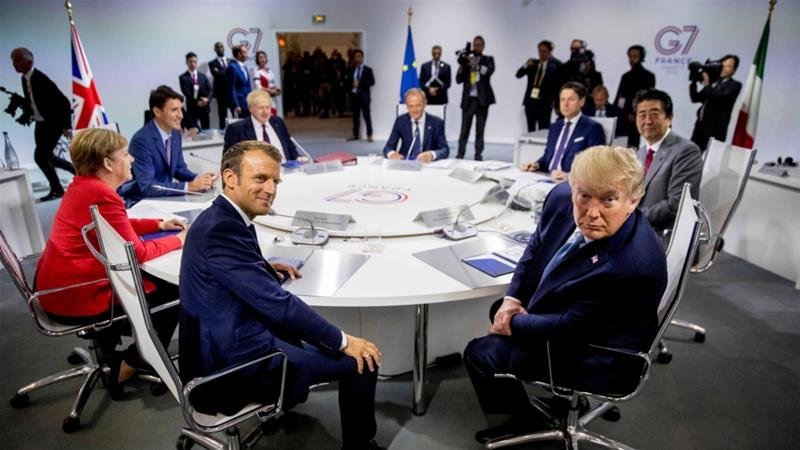The Bursting Bubble of G-7

The G7 summit is in news again as U.S President Donald Trump mentions the summit has been postponed till September this year which was supposed to be held from 10 to 12 June 2020 in Camp David, United States. Moreover, Trump has expressed his desire for expansion of G7 bloc to G10 or G11 and said “It’s a very outdated group of countries” and wish to invite other countries of the world to participate in the summit. The Group of Seven (G7) is a group of the most advanced economies consisting of seven countries namely Canada, France, Germany, Italy, Japan, United Kingdom and the U.S. Since Russia’s expulsion from G7 membership after the Crimean annexation in March 2014 which got reformatted from G8 to G7, it was the first since the U.S president talked about its plans to invite Russia along with other countries like South Korea, Australia and India for the meeting scheduled in September. And with Angela Merkel’s firm rejection of the U.S invite to attend in person in view of the overall pandemic situation she becomes the first among the member countries to give a firm no while other countries like U.K’s Boris Johnson responded in favour of convening the G7 in person in future.
A brief history of G7
The G7 is a multilateral body that was formed in 1975 among the world’s most developed economies of the world. France, Italy, Japan, the UK, U.S and West Germany were the original founding members. It was originally an alliance of only democratic countries. Later on, Russia joined the Group in 1998. Currently, the Group of seven accounts for 40 percent of the World’s GDP and represents 10 percent of the World’s population. The G7 had its origins when OPEC (Organization of the Petroleum Exporting Countries) oil embargo in 1973 led to inflation and recession and the World economic powers decided to come together and discuss economic matters.

The reaction of G7 Members of Trump’s Statement
G7 member countries didn’t oppose the expansion of G7 directly. However, it is interesting to note that Trump’s invitation to Russia has not been well received by the other G7 members mainly the UK and Canada. Canadian Prime Minister Justin Trudeau opposes Russian readmission into G7 saying “Russia’s continued disrespect and flaunting of international rules and norms is why it remains outside of the G7 and it will continue to remain out”. Likewise, UK’s Prime Minister Boris Johnson says it would veto any proposal of Russia’s rejoining of G7. Boris Johnson’s spokesperson stated that the United Kingdom is not in favour of Russia’s entry into the G7 group and will admit it only if it refrains from its “aggressive and destabilizing activity”.

Differences Among G7 Members in the Past
The G7 which calls itself as “a community of values” having certain key principles of freedom, human rights, democracy, rule of law including prosperity and sustainable development seems to have growing differences among its members’ countries in recent times. Like in the June 2018 summit of the G7 held in Quebec, Canada there were a lot of disagreements over trade and tariffs on steel and aluminium imports from Canada, the EU and Mexico and the US president even called out Canadian PM Trudeau as “meek and mild”. Responding to it, Canadian PM Justin Trudeau called-out Trump’s statement as “insulting”. One can say Trump’s “America First” and its various trade and economic policies too can be causing an increasing rift within the group members. The G7 summit that meets every year to discuss issues ranging from global governance, climate change, security as well as economy ended in disarray in its 44th Summit held at La Malbaie, Quebec since the US President decided to pull out of the Paris climate change accord and refused to sign it. Also despite advice from its European allies, the US pulled out of the Iran Nuclear Deal in May 2018. With U.S President Trump’s recent statement saying, “I don’t feel that as a G7 it properly represents what’s going on in the world” it is more and more reflective of the growing differences in the G7 as a group.

Evolving Dynamics of the G7
Keeping in mind the U.S President’s plan of expansion of the G7 which includes India, he had a conversation with India’s Prime Minister Narendra Modi over the phone to which he responded positively. India’s growing economy which is among the fifth largest economy in the world and India, Australia and South Korea axis also carries immense geopolitical importance to the U.S. Many experts also believe that this is a part of U.S counter-strategy to contain China’s influence in the Indo-Pacific. While India’s response is also moved by a strategic action to send signals of a G7 expansion and closer India-US relations due to an increasing border dispute with China. Few commentators also believe that the American President’s move of expanding the G7 is ill-fated and would fail due to the fact that although the US can send an invite to any country since it is the hosting this year’s G7 summit. But a proposal of permanent expansion of G7 into G-10 or G-11 needs the approval of other members as well. With Canada and the U.K already rejecting Trump’s proposal of inviting Russia, it raises a whole new question about the future of the structure of G7 and whether there has been a change in the Group of Seven since 1975 when it was first created consisting of the most advanced economies of the world. With newly emerging economies there has been a change in the world economic scenario and the impact can be seen in Group of Seven as well.

The way ahead
Just as Trump’s proposal of expanding the group might look welcoming for Australia, India and South Korea, leaving out China may clearly contradict from the original purpose of founding the G7 in the 1970s during the energy crisis in order to facilitate macroeconomic initiatives with the world’s most advanced economies. In such a scenario not inviting the world’s second-largest economy i.e China from the Group of Seven membership won’t be serving the original purpose of its formation. With the world reeling under Covid-19 crisis together with an economic slowdown, there has been further escalating of tensions between India-China and U.S-China. In such circumstances not inviting China will only widen the rift between the global powers. Instead of leaving the second-largest advanced economy of the world alone, G7 members should include China in the group that will not only increase the representation of world’s population in the forum, the organization will also provide an arena where all economic global players can come together to discuss, cooperate and disagree on their security, economic and political matters.



















